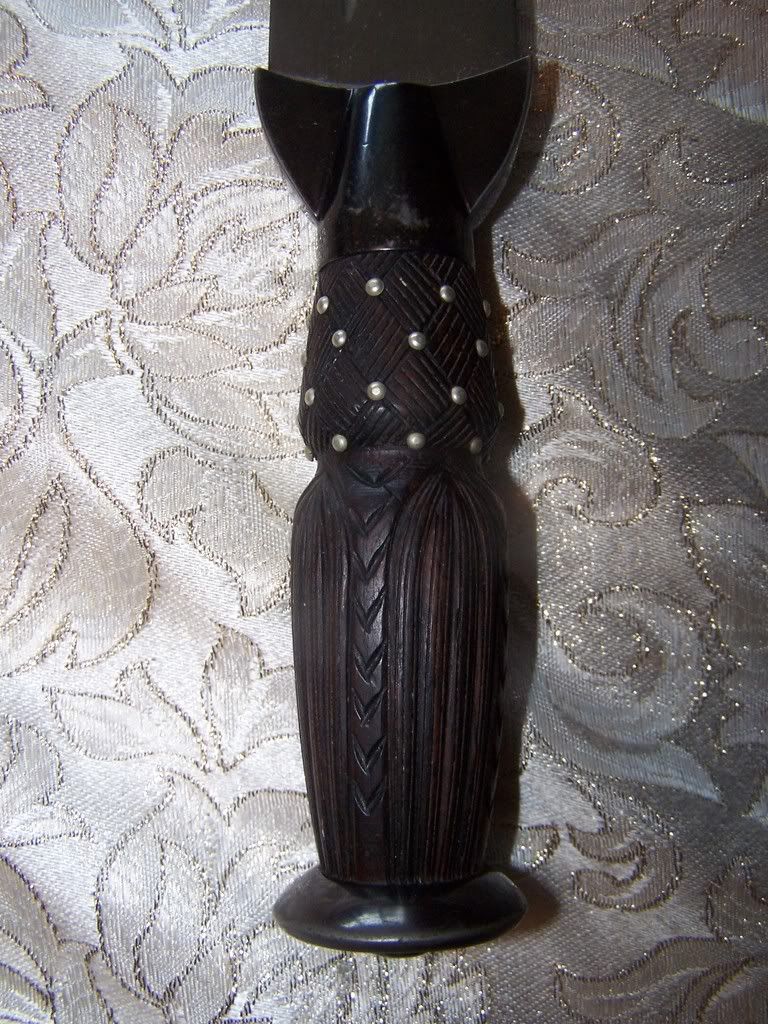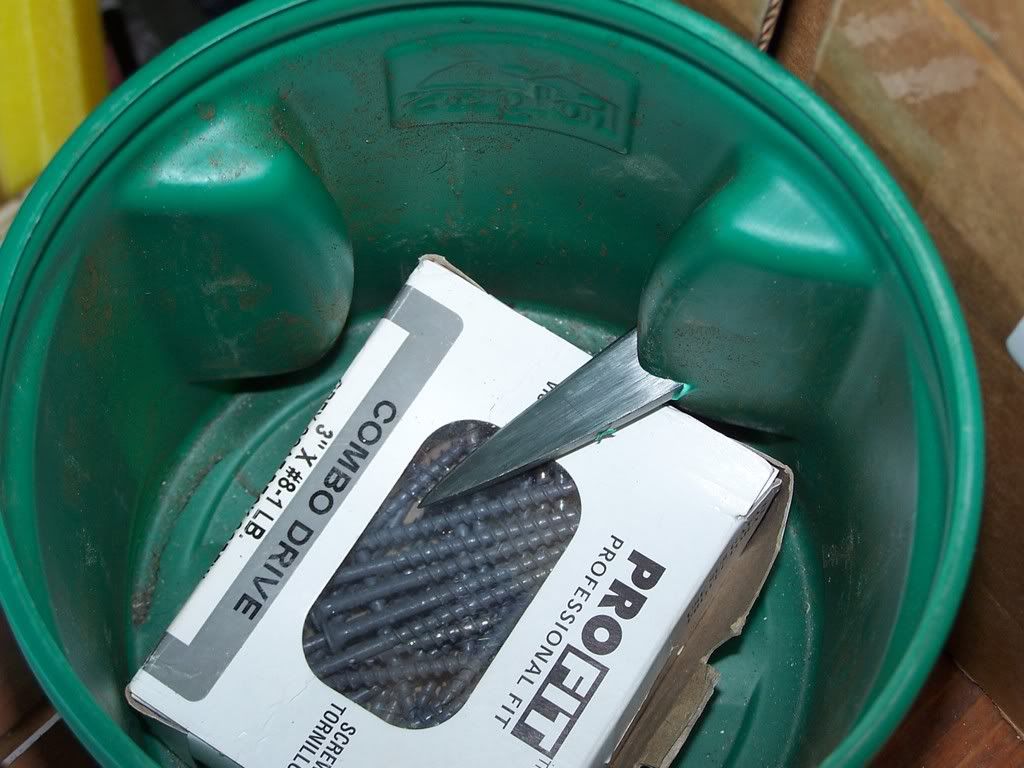Cold Steel's Scottish Dirk
Aug 2, 2007 15:18:14 GMT
Post by Deleted on Aug 2, 2007 15:18:14 GMT
Welcome, ladies and gents, to the second installment of Jake's Arsenal! I'm enjoying this whole reviewing thing, so I think I'll review another of my faves: the Scottish Dirk by Cold Steel.
Now, I think I mentioned elsewhere that I was fairly disappointed by CS's Viking Sword. Not only does it handle like a blade-heavy sharpened sledgehammer (well, it IS a blade-heavy sharpened sledgehammer), but the pommel is SCREWED IN!!! In the Viking Sword review thread here, I recall someone saying that having a screw-in pommel isn't necessarily a bad thing. Lemme tell you, it's plenty bad when the damn thing unscrews while you cut a free-standing cardboard box. The blade, while too rigid and easy to chip, is even sharper than my katana and could easily cut a man in half with a good chop.
I guess CS got their asses in gear when they designed the Scottish Dirk. This is my favorite short blade, I like it better than my wakizashi or my scramaseax. It's handsome enough to look good at your side for reenactments and sturdy enough to take a beating and keep going. In fact, the dirk is so nice that I can overlook the fact that it's of Scottish origin (normally an offense deserving burning at the stake ). Let's take a look at the fine details.
). Let's take a look at the fine details.


Cold Steel's website has this to say about the Dirk:
Which is great, but let's skip to the good stuff.
Specs:
Weight: 18.9 oz.
Thickness: 1/4"
Blade: 13"
Steel: 1055 Carbon
Overall: 18 3/8"
Scabbard: Leather w/ Blued Steel Fittings
Point of Balance: About an inch from the guard
Cold Steel lists the blade for a whopping US$189.99! Luckily, Kult of Athena, where I ordered the dirk, lists the dirk at a much-reduced US$104.95. Much more reasonable.
FIT AND FINISH
I seem to remember reading that the dirk comes from the medieval ballock knife. For the English among us, the term 'semprinis' needs little explanation. For those of you from barbaric foreign places, well...the 'handguard' had two bulges on either side of the blade, which is rather straight and long...and between two ball-shaped bulges...you get the picture.
The 'semprinis' of this dirk aren't quite as pronounced as its ancestor but are still there enough to be reasonably historically accurate. A Scot on SFI, reviewing this weapon, complained to no end about the historical inaccuracy of the materials used in the dirk. True, real dirks would have rarely used steel in the fittings, but it's good enough to give a close approximation.

The handle is made of hand-carved rosewood which is absolutely gorgeous to look at. Intricate lines and criss-cross patterns and little chevrons make this a pleasure to behold as well as to wield. The carvings also held a lot with gripping the blade. The top part of the wood is studded with decorative steel pins, after the fashion of later (19th century?) dirks worn by nobles. The pommel is a round, flat disk that helps keep the dirk in your hand during swings, but doesn't really get in the way of your wrist (or mine, at least. Big hands). It also helps to balance the blade.

(Just to show the size of the weapon compared to the size of a man's hand)
THE BLADE
The dirk came with a sort of 'certificate of authenticity' that said it had undergone the rigors of the 'British Proof Test', which basically means that they flexed the blade in ways that I would shudder to imagine before shipping it to me. I've never intentionally flexed one of my swords, nor will I, so I can't confirm or deny the flexy-ness of my dirk. I have done plenty to this weapon that should prove its strength and durability, and after a year, it's held up damn well.
The blade came well polished, but it's been so long since I got it that I forget what the polish looked like. Now the dirk looks like a proper weapon - that is to say, it's got scratches and some spots where the finish has been marred. Please note that after careful inspection of the blade, I can't see a single nick or chip in the edge. I've sharpened the blade a tiny bit before, but never to remove any nicks. Having faced wood, cardboard, and the usual stuff that we sword lovers force our babies to contend with, the blade is, structurally, in perfect condition.

The blade is double-fullered which makes it light and quick in your hand. However, it's very slim and doesn't have much weight to it. As you can see, the blade made little impact to this bottle (compliments to my father for drinking for the betterment of sword knowledge ).
).

Those cuts are deep enough, and the blade would certainly lacerate unarmored flesh, but armor would probably prove too much for the edge. I had to really chop at the bottle to do this:

I might be a good idea to expound a bit on the original use of the dirk. You see, a Scottish clansman would be armed with a sword, a targe (small shield), and a dirk. Now, if I'm wrong about any of this, the Scots among you are encouraged to correct me, but I believe that the sword would be wielded in one hand, with the dirk and the targe in the other. The dirk would be held in the hand while the targe was strapped to the arm, allowing the blade to extend just beyond the rim of the shield for sneaky thrusts against good, honest British soldiers. The dirk is a thrusting weapon, and a damn fine one. I would seriously pee myself at the prospect of being stabbed by this thing.

The Folgers can, used by my dad to hold nails, was used to keep the lightweight carboard boxes from moving while I stabbed them. In the end, the blade impaled both boxes, and the hard-plastic can, and a box of nails as well. It was harder getting the blade out than it was getting it in.


I have a healthy respect for the penetration power of this blade. While the cutting ability is less than I'm used to because of the light blade, I imagine the point could go through maille, leather, skin, muscle, and bone without much difficulty.
OVERALL/RATINGS
Historical accuracy=3/5 I've never seen pictures of a design exactly like this, and indeed most dirks actually used in battle were very plain. I think CS just took bits and pieces of designs used by various dirks and put them together in one very handsome weapon. Nothing about the blade is historically inaccurate, though, except for the steel guard and pommel, which would usually have been a different metal. It's entirely possible that a nobleman would have owned a dirk like this, though. Heh...owning a noble's blade for $105, what a steal!
Handling=5/5 The handle is the perfect size for my hand and the balance is good enough to let me swing it without noticing any weight whatsoever. It feels like it's part of your hand. Since I use a lot of wrist when I use knives, and because this is a very large knife, it does start to make your wrist hurt after a while. If you just thrust, however, you could keep going all day. Wipe the butter off of your KA-BAR and leave your other daggers at home; this is the best fighting dagger I've ever handled.
Structural integrity=5/5 Having taken the usual punishment and never failed to perform, I can say that this is a well-made weapon that you would have to try very hard to destroy.
Value for money= 4/5 by Cold Steel's outrageous price. Seriously, how do they justify their arm-and-a-leg price tags for mostly-mediocre swords? 5/5 if you order from Kult for a paltry $105. That's like $80 less than if you buy it directly. $105 for a blade that, I imagine, rivals the finest from Gen 2 and all the other producers of fine pointy things.

Yeah...crappy photography...
Now, I think I mentioned elsewhere that I was fairly disappointed by CS's Viking Sword. Not only does it handle like a blade-heavy sharpened sledgehammer (well, it IS a blade-heavy sharpened sledgehammer), but the pommel is SCREWED IN!!! In the Viking Sword review thread here, I recall someone saying that having a screw-in pommel isn't necessarily a bad thing. Lemme tell you, it's plenty bad when the damn thing unscrews while you cut a free-standing cardboard box. The blade, while too rigid and easy to chip, is even sharper than my katana and could easily cut a man in half with a good chop.
I guess CS got their asses in gear when they designed the Scottish Dirk. This is my favorite short blade, I like it better than my wakizashi or my scramaseax. It's handsome enough to look good at your side for reenactments and sturdy enough to take a beating and keep going. In fact, the dirk is so nice that I can overlook the fact that it's of Scottish origin (normally an offense deserving burning at the stake
 ). Let's take a look at the fine details.
). Let's take a look at the fine details. 

Cold Steel's website has this to say about the Dirk:
Our version is a modern replica that harkens back to an earlier form, when the dirk was a functioning tool and weapon. The 13" blade is forged to a hard spring temper from 1055 Carbon steel. It’s 11/2" wide and comes fully sharpened and battle-ready, prepared to hew down any foe.
The attractive Rosewood handle is capped with a contrasting blued-steel guard, bolster and disc-shaped pommel, and an handsome leather scabbard completes the package. The scabbard features an extra wide belt loop with a blued-steel throat and chape. This is the perfect companion piece to complete your Highland ensemble, a real fighting dirk, instead of a useless piece of metal.
The attractive Rosewood handle is capped with a contrasting blued-steel guard, bolster and disc-shaped pommel, and an handsome leather scabbard completes the package. The scabbard features an extra wide belt loop with a blued-steel throat and chape. This is the perfect companion piece to complete your Highland ensemble, a real fighting dirk, instead of a useless piece of metal.
Which is great, but let's skip to the good stuff.
Specs:
Weight: 18.9 oz.
Thickness: 1/4"
Blade: 13"
Steel: 1055 Carbon
Overall: 18 3/8"
Scabbard: Leather w/ Blued Steel Fittings
Point of Balance: About an inch from the guard
Cold Steel lists the blade for a whopping US$189.99! Luckily, Kult of Athena, where I ordered the dirk, lists the dirk at a much-reduced US$104.95. Much more reasonable.
FIT AND FINISH
I seem to remember reading that the dirk comes from the medieval ballock knife. For the English among us, the term 'semprinis' needs little explanation. For those of you from barbaric foreign places, well...the 'handguard' had two bulges on either side of the blade, which is rather straight and long...and between two ball-shaped bulges...you get the picture.

The 'semprinis' of this dirk aren't quite as pronounced as its ancestor but are still there enough to be reasonably historically accurate. A Scot on SFI, reviewing this weapon, complained to no end about the historical inaccuracy of the materials used in the dirk. True, real dirks would have rarely used steel in the fittings, but it's good enough to give a close approximation.

The handle is made of hand-carved rosewood which is absolutely gorgeous to look at. Intricate lines and criss-cross patterns and little chevrons make this a pleasure to behold as well as to wield. The carvings also held a lot with gripping the blade. The top part of the wood is studded with decorative steel pins, after the fashion of later (19th century?) dirks worn by nobles. The pommel is a round, flat disk that helps keep the dirk in your hand during swings, but doesn't really get in the way of your wrist (or mine, at least. Big hands). It also helps to balance the blade.

(Just to show the size of the weapon compared to the size of a man's hand)
THE BLADE
The dirk came with a sort of 'certificate of authenticity' that said it had undergone the rigors of the 'British Proof Test', which basically means that they flexed the blade in ways that I would shudder to imagine before shipping it to me. I've never intentionally flexed one of my swords, nor will I, so I can't confirm or deny the flexy-ness of my dirk. I have done plenty to this weapon that should prove its strength and durability, and after a year, it's held up damn well.
The blade came well polished, but it's been so long since I got it that I forget what the polish looked like. Now the dirk looks like a proper weapon - that is to say, it's got scratches and some spots where the finish has been marred. Please note that after careful inspection of the blade, I can't see a single nick or chip in the edge. I've sharpened the blade a tiny bit before, but never to remove any nicks. Having faced wood, cardboard, and the usual stuff that we sword lovers force our babies to contend with, the blade is, structurally, in perfect condition.

The blade is double-fullered which makes it light and quick in your hand. However, it's very slim and doesn't have much weight to it. As you can see, the blade made little impact to this bottle (compliments to my father for drinking for the betterment of sword knowledge
 ).
).
Those cuts are deep enough, and the blade would certainly lacerate unarmored flesh, but armor would probably prove too much for the edge. I had to really chop at the bottle to do this:

I might be a good idea to expound a bit on the original use of the dirk. You see, a Scottish clansman would be armed with a sword, a targe (small shield), and a dirk. Now, if I'm wrong about any of this, the Scots among you are encouraged to correct me, but I believe that the sword would be wielded in one hand, with the dirk and the targe in the other. The dirk would be held in the hand while the targe was strapped to the arm, allowing the blade to extend just beyond the rim of the shield for sneaky thrusts against good, honest British soldiers. The dirk is a thrusting weapon, and a damn fine one. I would seriously pee myself at the prospect of being stabbed by this thing.

The Folgers can, used by my dad to hold nails, was used to keep the lightweight carboard boxes from moving while I stabbed them. In the end, the blade impaled both boxes, and the hard-plastic can, and a box of nails as well. It was harder getting the blade out than it was getting it in.


I have a healthy respect for the penetration power of this blade. While the cutting ability is less than I'm used to because of the light blade, I imagine the point could go through maille, leather, skin, muscle, and bone without much difficulty.
OVERALL/RATINGS
Historical accuracy=3/5 I've never seen pictures of a design exactly like this, and indeed most dirks actually used in battle were very plain. I think CS just took bits and pieces of designs used by various dirks and put them together in one very handsome weapon. Nothing about the blade is historically inaccurate, though, except for the steel guard and pommel, which would usually have been a different metal. It's entirely possible that a nobleman would have owned a dirk like this, though. Heh...owning a noble's blade for $105, what a steal!
Handling=5/5 The handle is the perfect size for my hand and the balance is good enough to let me swing it without noticing any weight whatsoever. It feels like it's part of your hand. Since I use a lot of wrist when I use knives, and because this is a very large knife, it does start to make your wrist hurt after a while. If you just thrust, however, you could keep going all day. Wipe the butter off of your KA-BAR and leave your other daggers at home; this is the best fighting dagger I've ever handled.
Structural integrity=5/5 Having taken the usual punishment and never failed to perform, I can say that this is a well-made weapon that you would have to try very hard to destroy.
Value for money= 4/5 by Cold Steel's outrageous price. Seriously, how do they justify their arm-and-a-leg price tags for mostly-mediocre swords? 5/5 if you order from Kult for a paltry $105. That's like $80 less than if you buy it directly. $105 for a blade that, I imagine, rivals the finest from Gen 2 and all the other producers of fine pointy things.

Yeah...crappy photography...



 ). Two questions for Jake: 1. how is the pommel attached? 2. WHat's the deal with the hanger/belt loop/froggish looking thing on the sheath? Is that your own work or did it come with the dirk?
). Two questions for Jake: 1. how is the pommel attached? 2. WHat's the deal with the hanger/belt loop/froggish looking thing on the sheath? Is that your own work or did it come with the dirk?

